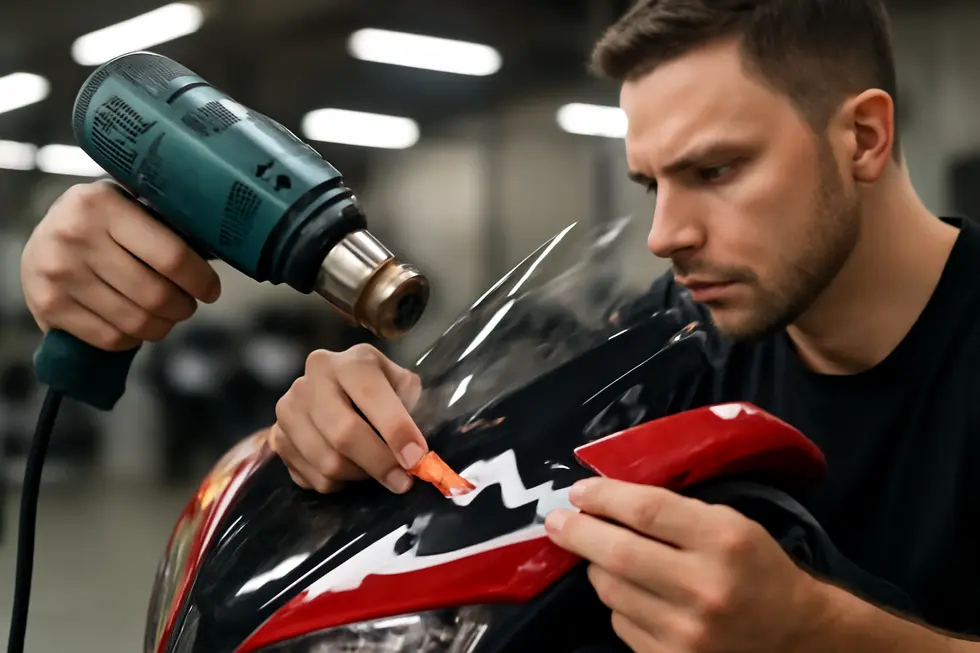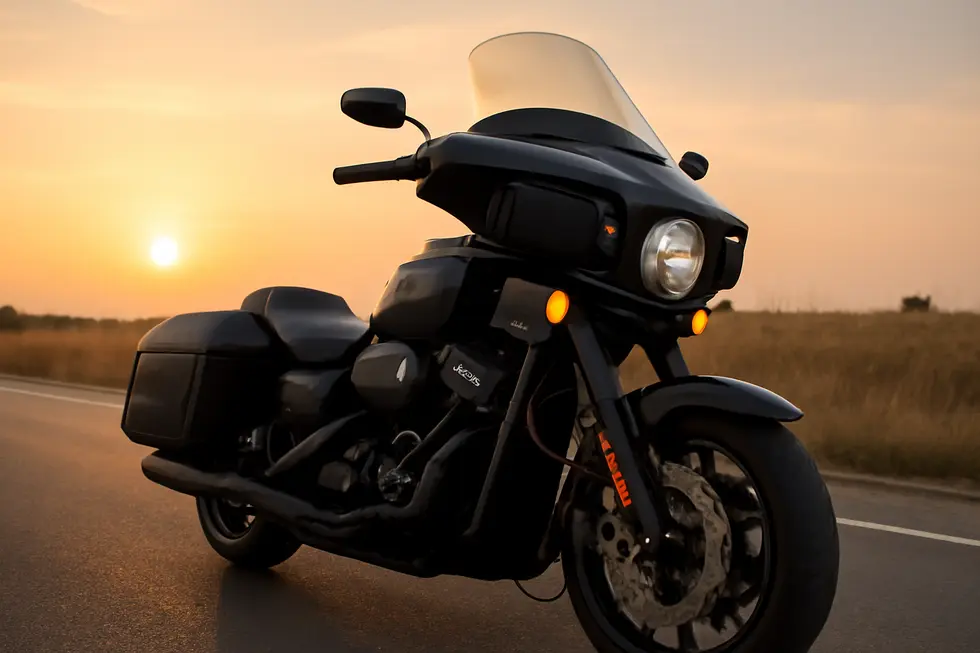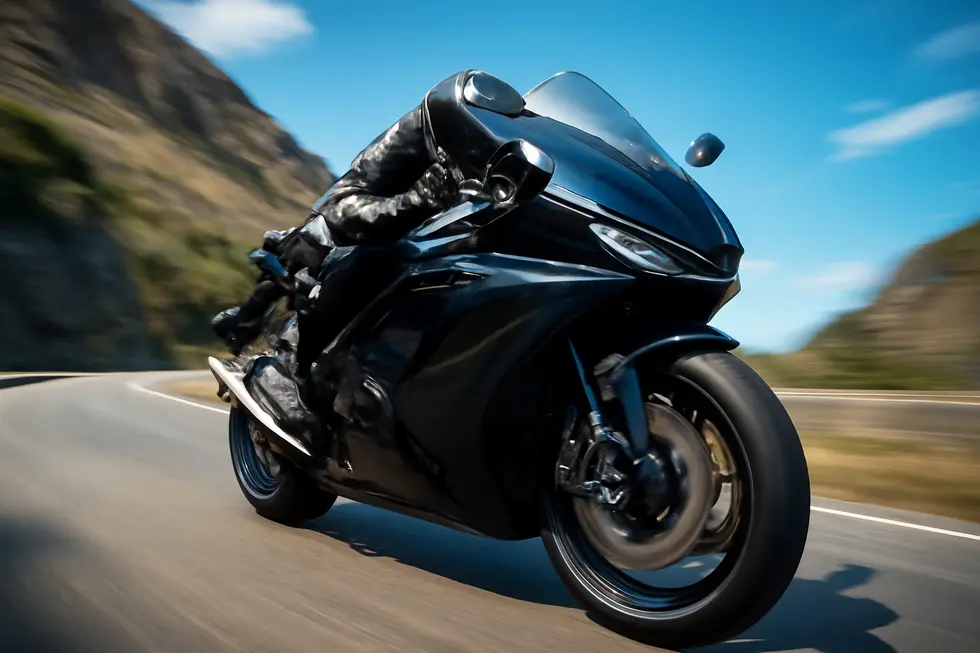Mastering the Art of How to Spray Motorcycle Fairings: A Business Guide
August 26, 2025 | by summitfairings
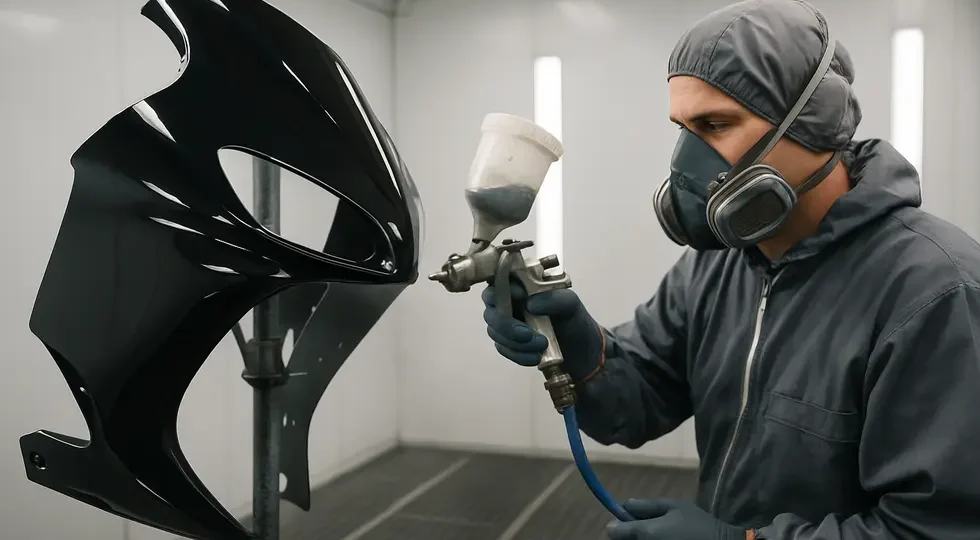
Introduction
For business owners in the motorcycle aftermarket industry, mastering how to spray motorcycle fairings is both an art and a critical skill that directly impacts customer satisfaction and brand reputation. Achieving a flawless, durable paint finish on fairings requires more than just equipment— it demands a comprehensive understanding of preparation, application, and finishing techniques. This process not only enhances the aesthetic appeal of motorcycles but also protects parts against environmental damage, thus extending their lifecycle. Each chapter of this guide delves into pivotal stages: thorough preparation and surface treatment ensure optimal adhesion and defect prevention; application techniques alongside material selection guarantee uniform, professional results; and finally, finishing plus curing processes safeguard durability and shine. Together, these chapters provide a cohesive roadmap for businesses aiming to elevate their paint services and deliver results that impress and endure.
Tables of Contents
Chapter 1: Thorough Preparation and Surface Treatment in How to Spray Motorcycle Fairings
- Mastering Surface Sanding and Cleaning for Flawless Motorcycle Fairing Paint Finishes
- Unlocking the Power of Primer: Essential Foundation for Flawless Motorcycle Fairing Paints
- Mastering Spray Techniques and Equipment for Flawless Motorcycle Fairing Finishes
- Mastering Clear Coat Application: The Key to Protecting and Perfecting Motorcycle Fairings
- Elevating Protection: Mastering Ceramic Coatings for Motorcycle Fairings’ Lasting Shine
Chapter 2: Mastering Application Techniques and Material Selection for Flawless Motorcycle Fairing Spraying
- Essential Surface Preparation: Cleaning, Sanding, and Material Considerations for Perfect Fairing Paint Adhesion
- Mastering Spray Application Methods for a Smooth, Durable Motorcycle Fairing Paint
- Mastering Material Choices and Paint Types for Seamless Motorcycle Fairing Spraying
- Enhancing Durability and Appearance: Protective Coatings and Finishing Strategies for Motorcycle Fairings
- Mastering Metal Surfaces: Tailored Techniques and Coatings for Spraying Motorcycle Fairings
Chapter 3: Finishing and Curing Processes in How to Spray Motorcycle Fairings
- Mastering Clear Coat Applications and Protective Finishes for Motorcycle Fairings
- Mastering Curing Time and Environmental Control for Durable Motorcycle Fairing Finishes
- Mastering Polishing and Buffing Techniques to Elevate Gloss and Smoothness on Cured Motorcycle Fairings
- Mastering Sanding and Color Sanding: Essential Refinement Steps Before the Final Finish
- Optimizing Finish Quality: HVLP Spray Systems and UV-Curing Acrylic Polyurethane Coatings for Motorcycle Fairings
Chapter 1: Thorough Preparation and Surface Treatment in How to Spray Motorcycle Fairings
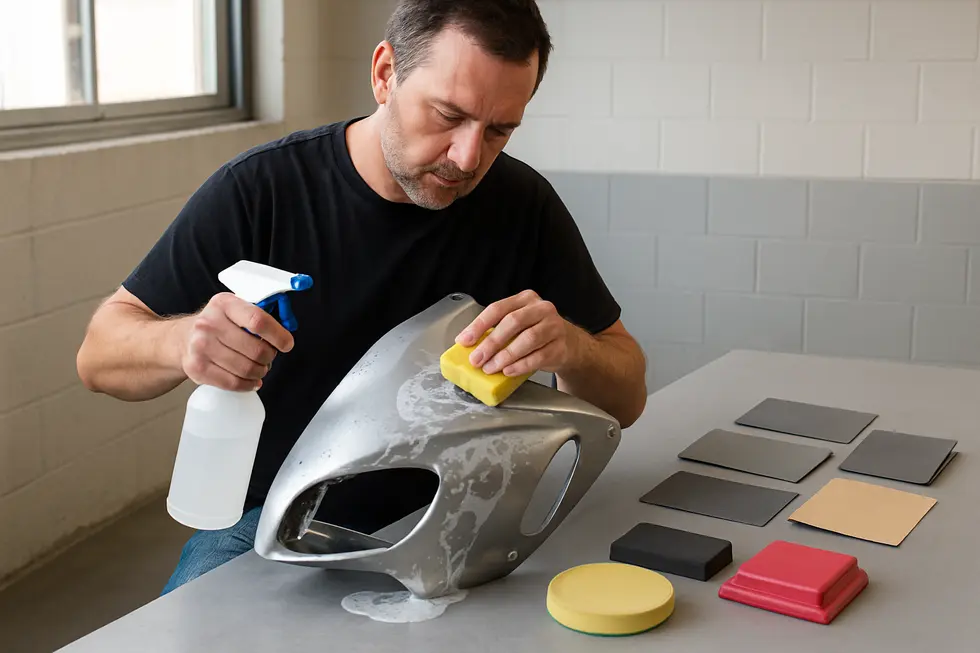
1. Mastering Surface Sanding and Cleaning for Flawless Motorcycle Fairing Paint Finishes
Surface sanding and cleaning form the foundation for a successful motorcycle fairing paint job, ensuring both durability and visual appeal. Proper sanding removes old paint, scratches, and surface imperfections, creating an even texture essential for paint adhesion. Starting with a medium grit such as 400, the sanding process smooths the surface, followed by progressively finer grits up to 800 or 1000 to refine it. This gradual progression prevents harsh scratches and maintains the integrity of plastic or fiberglass components. Larger flat areas benefit from orbital sanding tools, but care is needed to avoid over-sanding that can deform edges or thin the fairing. More intricate sections or delicate curves require hand sanding to maintain control and avoid damage. Attention to consistent technique and uniform pressure is pivotal to avoid unevenness that can later manifest as paint defects.
Once sanding is complete, meticulous cleaning is crucial to eliminate dust, grease, oils, and residues that could undermine primer and paint bonding. Isopropyl alcohol or dedicated plastic surface cleaners are ideal solvents that dissolve oils without harming the substrate. These solvents should be applied with clean microfiber cloths, ensuring debris removal and avoiding lint deposits. Drying the surface with filtered compressed air or clean, dry gauze removes residual particles and moisture, preventing surface contamination during primer application. Neglecting this step risks paint adhesion failures, such as peeling or bubbling.
This combined sanding and cleaning process forms the essential groundwork before primer or paint layers are applied. By addressing surface irregularities and contaminants, it establishes a pristine, receptive base that enables subsequent coatings to adhere properly and deliver a smooth, lasting finish. For further insights on preparation, exploring resources like the Summit Fairings blog can provide valuable guidance and tips from experienced practitioners.
2. Unlocking the Power of Primer: Essential Foundation for Flawless Motorcycle Fairing Paints
Primer application is a pivotal step in preparing motorcycle fairings for a professional paint finish. This foundational layer not only seals the fairing’s surface but also plays a critical role in enhancing paint adhesion and durability. Motorcycle fairings, often made from ABS plastic, require a primer specifically formulated for automotive plastics to ensure the paint bonds properly and resists peeling or flaking under stress.
The primer acts as a protective barrier, shielding the surface from moisture and environmental factors that could otherwise compromise the paint job. By filling in minor scratches and sanding marks, primer helps create a smooth and even canvas, eliminating surface imperfections that might show through the paint. This smoothing effect contributes significantly to the flawless appearance of the final finish.
Applying primer involves clean, dust-free surfaces prepared by prior sanding and degreasing, ensuring optimal bonding conditions. Usually, several thin coats are applied and allowed to dry thoroughly between applications to build a uniform protective film. This process not only reinforces the fairing’s surface but also establishes a texture conducive to subsequent layers of base color paint and clear coat.
Beyond aesthetic benefits, a well-applied primer dramatically improves the longevity of the paint job. It supports the multiple layers of paint and clear coat, enhancing resistance to wear, UV damage, and environmental exposure commonly encountered in motorcycle use.
For those seeking detailed, step-by-step guidance on primer application and complete surface preparation, professional tutorials offer invaluable insight. More information on this crucial phase of painting motorcycle fairings is available at Kings Motorcycle Fairings.
3. Mastering Spray Techniques and Equipment for Flawless Motorcycle Fairing Finishes
Achieving a smooth and durable finish on motorcycle fairings begins with mastering the spray painting techniques and selecting the right equipment. After the critical step of surface preparation ensures paint adhesion and an even base, the painting process relies heavily on controlled application. Whether using aerosol spray cans formulated specifically for automotive plastics or a professional spray gun paired with an air compressor, the choice of equipment impacts coverage and detail. Spray guns offer the advantage of adjustable pressure and nozzle size, allowing for a more precise application on the curves and contours typical of motorcycle fairings.
When spraying, maintaining the correct distance—typically 6 to 12 inches—from the surface is vital to avoid runs and uneven layers. Applying several thin coats rather than a single heavy coat helps build up color evenly and prevents drips. Between each coat, adequate drying time must be observed to lock in a uniform base for subsequent layers. Additionally, working within a dust-free, well-ventilated environment reduces contamination risks, while using proper masking tape protects areas not intended for painting, creating sharp, professional edges.
Beyond painting, using paints expressly formulated for plastic substrates enhances flexibility and adhesion, ensuring the finish remains resilient under stress and temperature variations. If ultra-smooth finishes are desired, wet sanding between base coats offers refinement prior to final clear coating. Incorporating these methods aligns with professional standards and supports long-lasting, visually striking fairing restoration. For detailed practical demonstrations and further tips on spray gun handling and coating techniques, resources such as this Instagram tutorial can provide valuable visual guidance.
For a wider range of motorcycle fairing options and inspiration, exploring specialty suppliers can help source quality parts ready for customization.
4. Mastering Clear Coat Application: The Key to Protecting and Perfecting Motorcycle Fairings
After carefully preparing motorcycle fairings through cleaning, priming, and applying base paint, the clear coat stage becomes essential in safeguarding and enhancing the finish. This transparent protective layer seals the color, preventing damage from environmental exposure such as UV rays, moisture, and abrasions. Applying one to two even layers of clear coat ensures a durable, glossy surface that resists scratches and chemical wear while restoring the vibrant look of the paint beneath.
The clear coat must be applied after the base color has completely dried to avoid imperfections like bubbling or peeling. Multiple thin coats, rather than a single heavy application, help achieve a smooth and uniform finish without runs or sags. Once applied, it is crucial to allow ample curing time in a dry, dust-free environment, shielding the fairings from moisture and contamination. This curing process hardens the clear coat into a robust shell that dramatically increases the longevity and visual appeal of the paint job.
For added resilience, some advanced systems incorporate ceramic coatings over the clear coat, forming an even tougher barrier that offers enhanced gloss and ease of maintenance. However, whether using standard clear coats or advanced protective layers, patience and precision during this step ultimately define the quality and endurance of the motorcycle’s appearance.
Thorough surface preparation combined with meticulous clear coat application prevents fading, cracking, and weather-related deterioration, maintaining a professional, showroom-worthy finish for years. For enthusiasts seeking affordable and quality components to begin this process, exploring a wide selection of motorcycle fairings and related tips can be a helpful starting point. Detailed guidance on surface treatment ensures your spray paint work delivers both beauty and lasting protection, critical in any thorough preparation routine.
For a deeper dive into fairing options suited for high-quality finishes, see the explore the best motorcycle fairings at Summit Fairings.
5. Elevating Protection: Mastering Ceramic Coatings for Motorcycle Fairings’ Lasting Shine
The final phase in thorough preparation and surface treatment for motorcycle fairings transforms the paint job into a resilient, high-performance finish by applying a ceramic coating. This advanced protective layer bonds chemically with the base coats, forming a semi-permanent shield that offers remarkable resistance against UV rays, chemical contaminants, and physical abrasion. Its hydrophobic nature repels water, dirt, and grime, making frequent rides easier to maintain and helping preserve the fairings’ flawless appearance over time.
Achieving this durable protection starts with meticulous surface preparation. Before the ceramic coating is applied, the fairings must be impeccably clean and smooth. This involves using isopropyl alcohol alongside a clay bar to eradicate wax, tar, and deeply embedded particles. Any swirl marks, scratches, or oxidation are then removed through careful polishing and paint correction, creating a polished surface that allows the coating to adhere effectively and uniformly.
Once the fairings are fully prepped, the ceramic coating is applied in thin, even layers. Its formulation fills microscopic imperfections in the paint, resulting in a hardened barrier that dramatically improves scratch resistance and prevents fading. Beyond durability, the coating contributes a slick, glossy finish that resists environmental factors like bug splatter and road grime, critical for preserving aesthetic appeal and reducing cleaning frequency.
For enhanced performance, some advanced formulations include graphene infusion, which adds heat resistance, anti-static properties, and improved longevity. These benefits are particularly valuable for motorcycles exposed to varied riding conditions and temperatures, offering an elevated level of protection.
In sum, ceramic coating as the concluding step of preparation locks in durability, gloss, and protection. This layer safeguards the investment made in earlier painting stages, ensuring your motorcycle fairings remain vibrant and battle-ready for years. For more tailored insights on choosing and applying protective treatments, explore the best motorcycle fairings and care tips at Summit Fairings.
For further details on advanced protective coatings, consider reviewing the comprehensive guide on nano sealants and graphene coatings available here.
Chapter 2: Mastering Application Techniques and Material Selection for Flawless Motorcycle Fairing Spraying
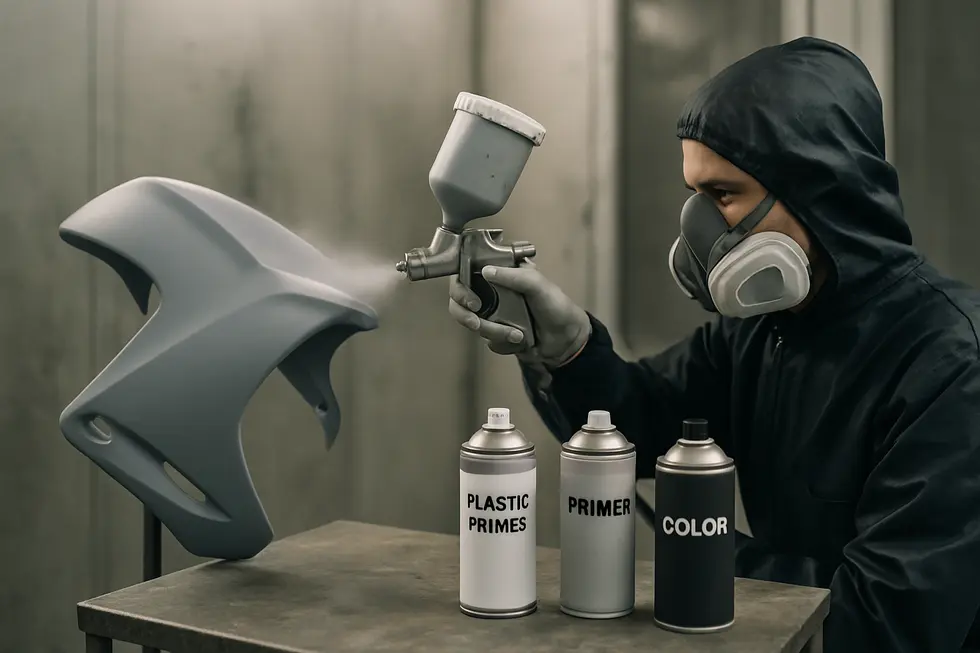
1. Essential Surface Preparation: Cleaning, Sanding, and Material Considerations for Perfect Fairing Paint Adhesion
Achieving a professional spray finish on motorcycle fairings begins with meticulous surface preparation, the foundation for excellent paint adhesion and durability. Initially, thoroughly cleaning the fairings removes dirt, grease, and microscopic residues that impede paint bonding. This process typically involves washing with wax-free automotive soap, followed by wiping down with isopropyl alcohol to eliminate oils and silicone contaminants invisible to the naked eye. For sensitive surfaces such as matte finishes, specialized preparation sprays combining mild alcohols with surfactants and lubricants prevent swelling or damage, offering a gentler alternative that maintains surface integrity.
Sanding is equally vital, as it creates the surface texture needed for primer and paint to adhere properly. Light sanding with fine-grit paper smooths out minor scratches and uneven areas. This step also prepares the fairings for any protective applications, like Paint Protection Film (PPF), by ensuring an ultra-smooth substrate for flawless bonding. However, selecting the proper abrasive method depends on the material composition of the fairings. For example, ABS plastic requires delicate sanding techniques, while aluminum components may benefit from silicon carbide abrasive media. Steel parts respond best to ceramic abrasives, and exotic materials like titanium necessitate zirconia-based media to avoid deformation during finishing.
After careful cleaning and sanding, avoiding harsh chemicals during the process preserves the surface’s readiness for painting. Once the paint job is complete, applying a protective wax layer helps maintain gloss and guards against UV damage, extending the finish’s longevity. Such detailed preparation practices, combined with suitable materials for sanding and cleaning, distinguish a durable and visually appealing motorcycle fairing spray job. For a deeper guide on sourcing quality motorcycle fairings to complement your painting efforts, explore this comprehensive resource from Summit Fairings.
Learn more about affordable motorcycle fairings at Summit Fairings.
For further insights into surface prep techniques and substrate-specific finishing methods, see detailed technical studies on finishing abrasives and protection films.[4]
2. Mastering Spray Application Methods for a Smooth, Durable Motorcycle Fairing Paint
Achieving an impeccable finish on motorcycle fairings relies heavily on mastering the spray application techniques tailored to plastic substrates. The process begins with selecting the appropriate equipment, where airbrushes and spray guns each serve distinct roles. Airbrushes excel at detailed work, such as repairing scratches or adding custom designs, due to their fine control over paint flow and coverage. Spray guns, in contrast, are preferred for large-scale, full-fairing coverage because they deliver an even mist over broad surfaces efficiently.
Effective spray application depends on precise technique—operators typically hold the spray device at a 45-degree angle, executing diagonal passes across the surface. This is followed by cross-coating in the opposite diagonal direction to blend each layer seamlessly and eliminate visible streaks. Maintaining consistent speed and distance during spraying is critical; moving too fast results in thin, uneven coverage, while going too slow encourages runs and drips.
Material compatibility is another crucial factor. Paints and primers must be specifically formulated for automotive plastics to adhere properly without damaging the surface. Some prep sprays gently lubricate the plastic to prevent swelling or adhesion failure while allowing paint to bond securely. Between each coat, allowing appropriate flash or drying time prevents layers from running and fosters smooth, durable finishes.
Surface preparation intersects closely with application, as clean, oil-free fairings paired with compatible primers ensure optimal paint adhesion. Working in a well-ventilated, dust-free environment safeguards against airborne imperfections. Combining these methods with patience and precision ultimately results in a professional-quality, long-lasting paint job.
For deeper insights into airbrush techniques applied to custom motorcycle paintwork, Gauge Magazine offers an excellent resource on employing diagonal and cross-coating passes for uniform finishes Gauge Magazine.
For additional inspiration and guidance on motorcycle fairings and finishes, visit the detailed resources at Explore the best motorcycle fairings at Summit Fairings.
3. Mastering Material Choices and Paint Types for Seamless Motorcycle Fairing Spraying
Achieving a durable and visually appealing finish when spraying motorcycle fairings depends heavily on selecting the right materials and paint types tailored specifically for the substrate. Motorcycle fairings are predominantly made from ABS plastic, valued for its strength and impact resistance. This makes it crucial to use plastic-specific spray paints engineered for such surfaces. These paints offer reliable adhesion and flexibility, accommodating the fairings’ slight movements and preventing cracking or peeling over time.
Before painting, the fairings must be thoroughly cleaned and deprived of any dirt, grease, or contaminants. This ensures that paint bonds effectively to the plastic surface. Applying paint in multiple thin coats is essential; a light initial coat helps with adhesion, while subsequent layers build color depth and uniform coverage without runs or drips.
Spraying in even, sweeping motions helps maintain consistent application, especially in a well-ventilated environment free from dust. Patience between layers is key, allowing each coat to dry properly before proceeding. For those aiming to customize or achieve deeper color effects, layering and masking techniques open opportunities for intricate patterns or color blocking with professional results.
Finishing with a clear coat adds a protective barrier, enhancing gloss and resistance to abrasion, UV exposure, and weathering. This step not only preserves the paint but also contributes to the overall longevity and aesthetic of the fairings.
For motorcyclists seeking quality and variety in replacement parts, explore Summit Fairings’ extensive selection to find suitable materials that complement professional paint applications.
Applying plastic-specific paints with careful technique ensures the final look is professional, resilient, and tailored to the demands of motorcycle use.
4. Enhancing Durability and Appearance: Protective Coatings and Finishing Strategies for Motorcycle Fairings
Achieving a flawless finish on motorcycle fairings goes beyond just applying paint; it demands strategic selection of protective coatings and refined finishing techniques tailored to the fairing’s material, usually high-quality ABS plastic. Proper surface preparation remains paramount: utilizing mild prep sprays designed for automotive plastics ensures strong adhesion without compromising delicate matte or gloss finishes. Avoiding alcohol-based solvents and painting on cool surfaces prevents issues like uneven texture or premature drying.
Once primed and painted, protective layers serve as the cornerstone for longevity and aesthetic appeal. Ceramic coatings are increasingly favored as they deliver exceptional scratch resistance and UV protection while preserving the underlying paint’s vibrancy. These coatings form a resilient barrier against environmental damage, making them ideal for fairings frequently exposed to harsh weather and road debris. Complementing ceramic protection, periodic application of specially formulated waxes enhances gloss and reinforces the surface against wear and oxidation.
The finishing process benefits significantly from precise spray techniques. Using airbrush or spray equipment, applying diagonal passes at a 45-degree angle with subsequent cross-coating in the opposite direction creates a visually seamless and smooth surface, effectively eliminating visible spray lines. Flash times between coats are critical to prevent runs or pooling and to build even coverage gradually.
In the event of minor damage like scratches or chips, careful sanding using fine grit—up to 2500—followed by targeted airbrush touch-ups allows for precise color matching and restoration without full repainting. This approach maintains the integrity of the original finish and extends fairing lifespan.
By integrating careful material selection with advanced protective and finishing methods, motorcyclists and professionals alike can ensure their fairings retain showroom quality and durability. For a deeper dive into ceramic coating applications tailored to plastics, see [1]. To explore quality motorcycle fairings ideal for refinishing projects, visit this source.
5. Mastering Metal Surfaces: Tailored Techniques and Coatings for Spraying Motorcycle Fairings
Spraying motorcycle fairings made of metal demands a precise understanding of the unique challenges and requirements these surfaces present. Metals like aluminum and steel differ significantly in their reaction to primers, paints, and finishing processes—making material-specific preparation essential for a durable, high-quality finish.
To begin, metal fairings require meticulous cleaning to remove oils, dirt, and oxidation that undermine paint adhesion. Aluminum alloys, such as 6061 and 7075, need primers formulated to accommodate their surface chemistry and potential anodizing treatments. Steel fairings frequently benefit from corrosion-resistant primers or a protective plating layer, such as zinc or nickel, before painting to prevent rust under the surface.
Surface texture is another critical aspect. Metal parts often undergo specialized finishing processes that vary by metal type: aluminum favors plastic media embedded with silicon carbide abrasives to avoid deformation, whereas steel typically uses more aggressive ceramic media to refine the surface rigorously. Sanding with fine-grit paper (400-600 grit) between coats helps create an even base essential for flawless metallic finishes and clear coats.
When selecting coatings, compatibility with the underlying metal ensures long-lasting adhesion and aesthetic uniformity. Aluminum primers are designed to prevent common issues like white spotting and uneven coloration, while stainless steel parts might employ polishing or advanced wear-resistant coatings such as PVD (Physical Vapor Deposition) for enhanced durability.
Beyond aesthetics, the choice of coatings must also address environmental challenges. Paints and clear coats that offer corrosion resistance, UV protection, and mechanical durability are imperative since motorcycle fairings face harsh outdoor exposure. This careful selection of primers, paints, and surface treatments tailored to metal types not only enhances visual appeal but guarantees a finish resilient to weather and wear.
For those interested in deeper details on metal finishing techniques and media selection, comprehensive mass finishing guides provide valuable insights tailored to motorcycle parts applications. This specialized approach is key to mastering metal fairing renovations and achieving professional-grade spray finishes. For more on choosing the right fairings and their maintenance, explore options at Summit Fairings blog.
Chapter 3: Finishing and Curing Processes in How to Spray Motorcycle Fairings
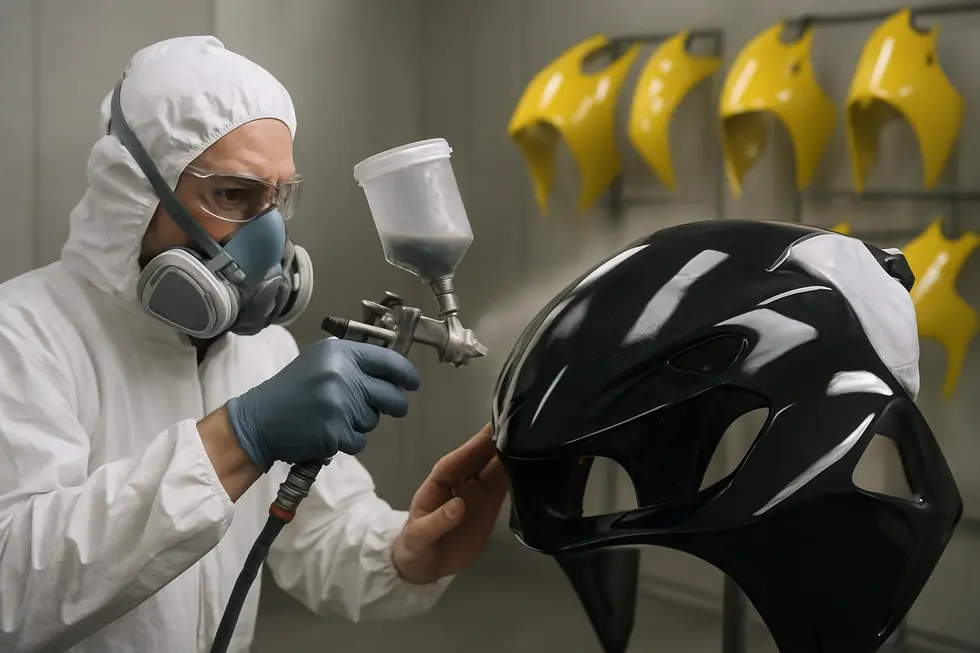
1. Mastering Clear Coat Applications and Protective Finishes for Motorcycle Fairings
Achieving a durable and visually appealing finish on motorcycle fairings hinges on expertly applying clear coats and protective layers during the final stages of spraying. After ensuring the surface is meticulously cleaned and sanded, the primer must create a smooth and stable base. Once this foundation is set, the clear coat is applied carefully to seal the color and enhance the finish’s depth and gloss.
Applying clear coat involves spraying multiple thin, even layers rather than one heavy coat. Each layer should flash off—that is, partially dry—to prevent runs, drips, or uneven textures. This controlled layering results in a clear surface that is strong enough to resist wear and environmental exposure. The curing process afterward is equally critical, often requiring a dust-free environment with stable temperature conditions to allow the clear coat to harden fully and develop optimum durability.
Beyond standard clear coats, many enthusiasts opt for advanced protective layers, such as ceramic coatings. These enhance resistance to scratches, chemical damage, and UV degradation. When working with matte finishes, it is especially important to use protective products tailored to maintain the desired sheen without unwanted glossiness. Improper polishing or protective treatments can alter matte finishes by introducing shine, so specialized care is vital.
Post-application techniques like wet sanding and polishing can refine the surface further, removing minor imperfections such as orange peel texture. These steps use abrasive compounds applied delicately to avoid compromising the integrity of the clear coat.
Together, these finishing techniques ensure motorcycle fairings not only look professional and glossy but also stand up to handling and environmental challenges over time. For a deeper dive into completing your bike’s appearance with high-quality parts and finishes, visit the Explore the Best Motorcycle Fairings at Summit Fairings blog.
For comprehensive guidelines on the technical details of clear coat application and curing, this resource provides further valuable insights: https://www.axalta.com/knowledge-center/automotive-paint-coating-basics.html
2. Mastering Curing Time and Environmental Control for Durable Motorcycle Fairing Finishes
Achieving a durable and professional finish on motorcycle fairings goes beyond applying paint; the curing stage is crucial for proper adhesion and long-term protection. Typically, curing requires 24 to 48 hours, during which the fresh paint must be shielded from any disturbances. Avoiding exposure to dust, moisture, or harsh weather prevents surface contamination and ensures the coating fully hardens. It’s equally important not to wash or ride the motorcycle aggressively during this period, as such actions can compromise the integrity of the finish.
Environmental factors significantly influence the curing outcome. Temperature fluctuations can slow or unevenly affect the drying process, while high humidity or moisture may weaken adhesion and cause imperfections like bubbling or blushing. Dust particles settling on the still-tacky surface can mar the finish or embed in the coating, reducing its gloss and durability. Ideal curing conditions involve moderate, stable temperatures and dry, clean air environments to promote a uniform hardening process.
Advanced techniques, such as infrared (IR) curing, offer benefits for consistent and accelerated drying. IR curing encourages a harder surface and enhances resistance to mechanical wear and chemical exposure. Though beneficial, such methods require controlled settings and careful monitoring to avoid overheating or surface damage.
During this critical phase, aggressive cleaning methods such as high-pressure washing or abrasive treatments should be avoided to protect the delicate new coating. Gentle handling and controlled environmental management are key to maintaining the finish’s quality.
By combining sufficient curing time with attentive control of temperature, humidity, and cleanliness, the paint bonds firmly to the substrates. This vigilance yields a resilient and visually striking coating that withstands UV exposure, abrasion, and weather effects.
For practical insights into protecting and finishing motorcycle fairings, you may find additional valuable information at Summit Fairings Blog.
More technical details on curing processes and paint protection films can be explored through resources like Garware Hi-Tech Films.
3. Mastering Polishing and Buffing Techniques to Elevate Gloss and Smoothness on Cured Motorcycle Fairings
Once the paint and clear coat on motorcycle fairings have fully cured, polishing and buffing become the critical steps that transform the finish from good to professional. These techniques refine the surface by removing minor imperfections such as swirl marks, light scratches, and an orange peel texture often left from spraying. Performing this process on fully cured layers ensures the paint’s integrity, avoiding damage and promoting a durable, glossy finish.
Polishing usually begins with wet sanding when necessary. Using fine-grit sandpaper, typically 1500 to 3000 grit, it gently levels uneven areas without harming the clear coat beneath. This step smooths out surface irregularities that polishing compounds alone cannot address. After sanding, polishing compounds are applied with a dual-action polisher or buffing wheel, working in slow, controlled circular motions. Starting with a more abrasive compound and progressing to finer ones gradually enhances clarity and shine.
Buffing follows polishing and involves softer pads that further even out the finish, deepen gloss, and impart a mirror-like smoothness. It is important to perform these steps on a cool surface away from direct sunlight to prevent heat-related problems such as hazing or streaking. Consistency and patience during buffing deliver a flawless result that catches light beautifully and enhances the paint’s protection against dirt buildup.
This finishing sequence not only boosts visual appeal but also strengthens the surface’s resistance to daily wear. Proper polishing and buffing underscore the quality of the spray painting process, turning your motorcycle’s fairings into gleaming, smooth masterpieces that showcase craftsmanship and care.
For a comprehensive guide on mechanical polishing techniques for motorcycle finishes, see Fresh Layer’s DIY Paint Correction Guide.
Explore more about choosing the right parts and treatments for your bike at our detailed resource on exploring the best motorcycle fairings.
4. Mastering Sanding and Color Sanding: Essential Refinement Steps Before the Final Finish
Sanding and color sanding play vital roles in achieving a flawless finish during the finishing and curing stages of spraying motorcycle fairings. These processes ensure the surface is perfectly smooth, enabling paint and clear coats to adhere properly and look visually pristine.
Initial sanding focuses on smoothing out any repairs, scratches, or filler applied during earlier steps. Using fine abrasive papers, typically between 800 and 1000 grit, the painter methodically levels imperfections on the fairings’ surface. This prepares the substrate for primer application, ensuring the primer can bond evenly and fill minor surface gaps effectively. For instance, when addressing deep gouges or filler patches, starting with 800 grit and progressing to 1000 grit creates a uniform base free from uneven spots or rough areas.
Once the primer and base color coats are applied, color sanding is employed to refine the surface by wet-sanding with very fine grits ranging from 1500 to 2000 or higher. This delicate process removes minor orange peel textures, dust nibs, and other subtle flaws that develop between layers. Color sanding smooths each coat’s surface before subsequent paint or clear layers, restoring a mirror-like gloss which greatly enhances the depth and clarity of the final finish.
This careful layering and sanding sequence—preparing raw or repaired surfaces, priming, applying multiple color coats, followed by color sanding and clear coats—ensures durability and an impeccable aesthetic on motorcycle fairings. Always cleaning surfaces with a degreaser or alcohol before priming is crucial to avoid adhesion issues caused by oils or contaminants.
For riders and refinishing enthusiasts seeking high-quality results, mastering sanding and color sanding steps balances technical precision with patient refinement, safeguarding both the paint’s longevity and visual impact. For more insights on quality motorcycle fairings and refinishing techniques, explore this ultimate source for affordable motorcycle fairings.
External resource: https://blog.summitfairings.com/your-ultimate-source-for-affordable-motorcycle-fairings/
5. Optimizing Finish Quality: HVLP Spray Systems and UV-Curing Acrylic Polyurethane Coatings for Motorcycle Fairings
Achieving a premium finish on motorcycle fairings demands advanced technology and materials beyond basic spray painting. High Volume Low Pressure (HVLP) spray systems are pivotal in this stage. By atomizing coatings efficiently with low air pressure, HVLP guns minimize overspray and allow meticulous control over paint thickness, especially on complex fairing contours. This precision reduces paint waste while ensuring a consistent, smooth layer that forms the foundation for durability and appearance.
Equally important is the selection of coating materials suited for the demanding conditions motorbike fairings face. UV 2K acrylic polyurethane coatings exemplify such innovation. These two-component systems chemically cure rapidly when exposed to UV light, unlike traditional air-drying or heat-curing methods that can require lengthy wait times. The resulting finish offers remarkable chemical resistance, gloss retention, flexibility, and abrasion resistance—critical attributes considering exposure to weather elements, fuel, and road debris.
Surface preparation prior to application is crucial. Filling imperfections with glazing putty and sanding to a flawless smoothness ensures these coatings bond perfectly, preventing defects like peeling or orange peel texture. Primer application tailored for plastics further enhances adhesion. After spraying the base coat with HVLP precision, the UV-curable clear coat is applied, sealing the finish. Instantaneous curing under UV light not only slashes production time but also solidifies a hard, resilient surface.
In some advanced manufacturing scenarios, such as with carbon fiber fairings, autoclave curing precedes paint application, enhancing composite integrity and finish quality. Post-curing, specialized matte or silk matte topcoats can be layered to balance aesthetic preferences with additional protection.
Integrating HVLP technology and UV 2K acrylic polyurethane coatings elevates the finishing and curing process, delivering motorcycle fairings that combine striking visuals with long-lasting performance.
For further guidance on sourcing quality fairings suited for advanced finishing techniques, explore a premium selection of motorcycle fairings.
Final thoughts
Achieving professional-quality paint results on motorcycle fairings is a methodical process crucial for any business aiming to thrive in the competitive motorcycle aftermarket industry. From rigorous surface preparation to precise application techniques and diligent finishing steps, each phase contributes to the overall durability, appearance, and value of the product offered to customers. By investing time in preparation, selecting appropriate materials, and respecting curing times, businesses not only enhance the visual appeal of fairings but also minimize rework, increase customer satisfaction, and strengthen brand reputation. Embracing these best practices ensures your motorcycle painting service stands out and sets a standard of excellence in both craftsmanship and reliability.
Ready to elevate your ride? Summit Fairings delivers premium, custom-fit fairings that blend style and durability. Whether you’re chasing speed or turning heads, we’ve got your bike covered. Don’t wait—transform your machine today. Click, customize, and ride with confidence. Your perfect fairing is just a few clicks away. Act now!
About us
We are one of the leading motorcycle fairing export sites, with over 3,000 styles covering almost all motorcycle models. Buy from summitfairings.com and save 10-40% compared to other sites. Have questions? We guarantee a response within six hours to assist you promptly.
RELATED POSTS
View all

